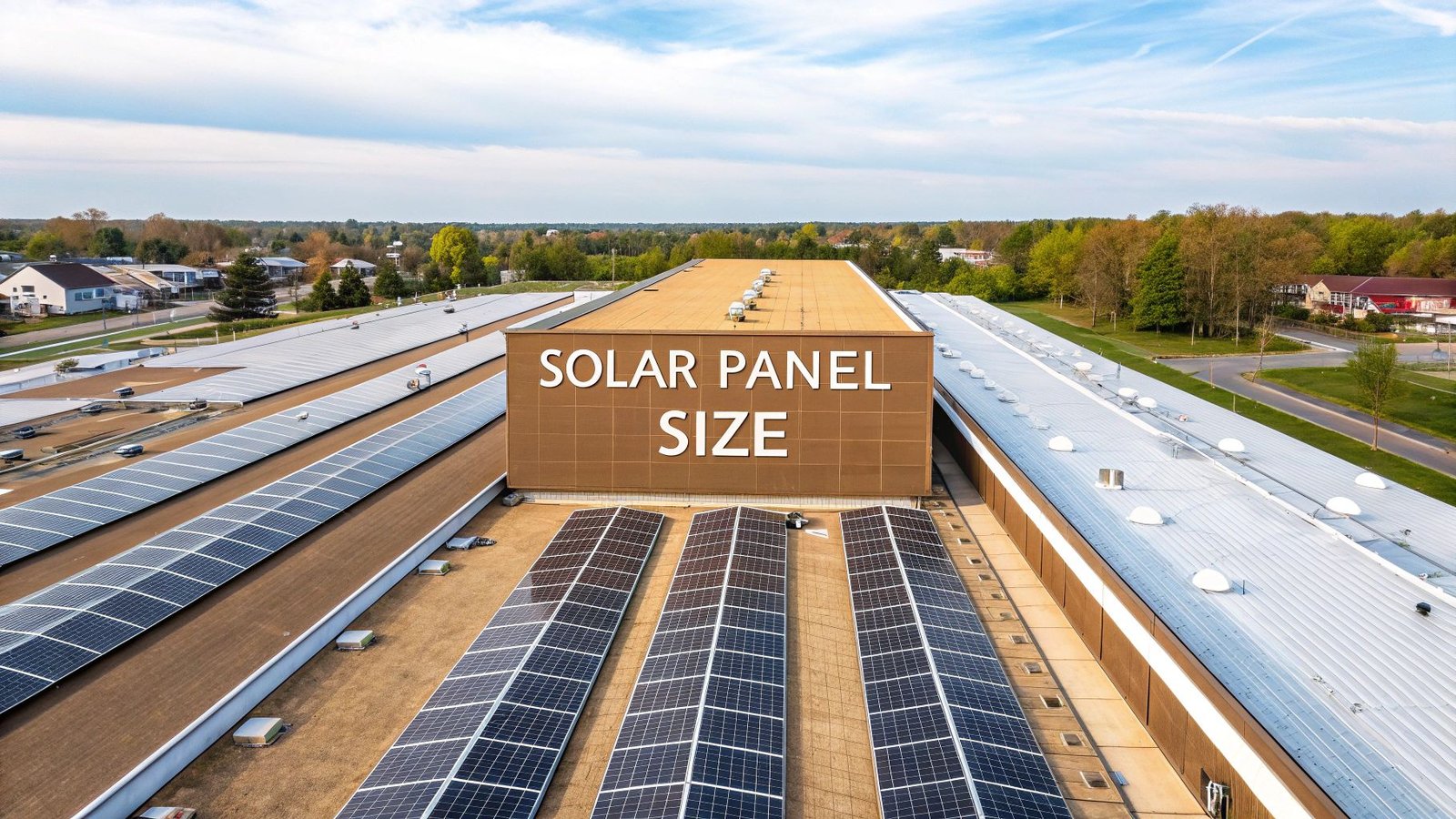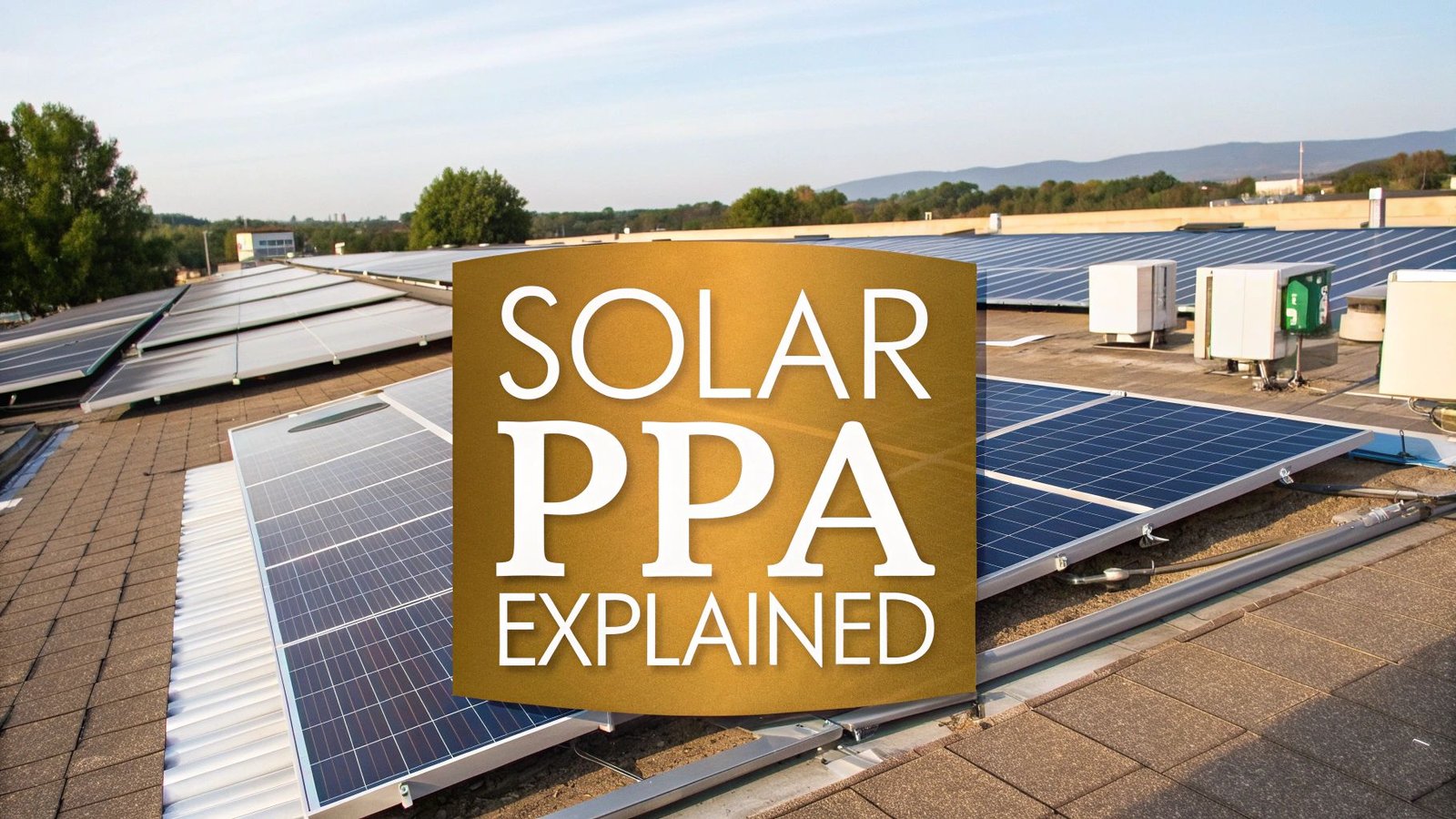If you’ve ever wondered just how big a solar panel is, there's a pretty straightforward answer for most homes. The typical residential panel is about 65 inches by 39 inches—or roughly 1.6 by 1 meter.
A good way to picture it is a large beach towel. It’s substantial enough to capture a lot of sunlight but still compact enough to fit neatly on your roof.
Understanding Solar Panel Dimensions
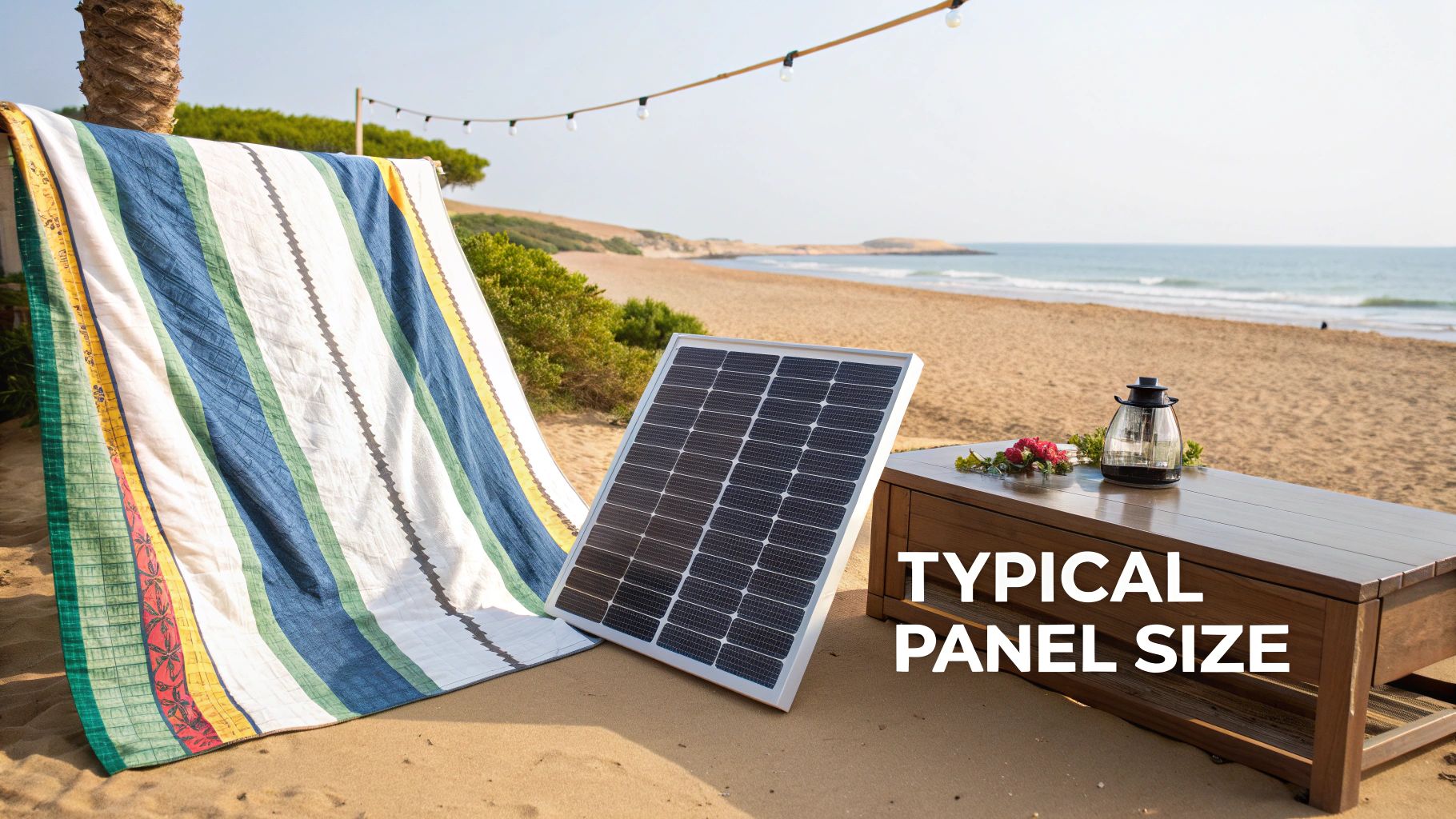
While that "beach towel" analogy is a great starting point, the truth is that solar panels aren't a one-size-fits-all product. A panel's size is directly linked to its power output, the technology packed inside, and what it’s designed to do.
Getting a handle on these differences is a crucial first step in understanding how home solar works and figuring out the perfect setup for your own property.
Residential vs Commercial Panels
For homeowners, it's all about getting the most energy out of a limited rooftop space. This has naturally led to a standard size that strikes a perfect balance between power generation, ease of handling, and installation.
Commercial panels, on the other hand, are a different beast. They are often bigger and heavier because they're built for wide-open spaces like massive, flat warehouse roofs or solar farms. In those scenarios, the main goal is cramming as much power into each panel as possible, and the installation logistics are completely different.
A standard residential panel, covering about 1.6 square meters, will usually generate between 300 to 400 watts, all depending on its efficiency.
Key Takeaway: Residential panels are designed for the perfect blend of size, weight, and power to suit a typical home's roof. Commercial panels go all-in on power output for large-scale projects.
To put it all into perspective, here’s a quick side-by-side comparison.
Typical Solar Panel Dimensions at a Glance
graph TD
subgraph Residential Panels
A[Dimensions: 65" x 39"]
B[Weight: 40-50 lbs]
C[Wattage: 300W - 450W]
end
subgraph Commercial Panels
D[Dimensions: 77" x 39"]
E[Weight: 50-60 lbs]
F[Wattage: 400W - 550W+]
end
This table breaks down the common specs you'll find for both residential and commercial panels.
| Panel Type | Average Dimensions (Inches) | Average Weight (lbs) | Typical Wattage |
|---|---|---|---|
| Residential | 65" x 39" | 40-50 lbs | 300W – 450W |
| Commercial | 77" x 39" | 50-60 lbs | 400W – 550W+ |
As you can see, while they might look similar from a distance, the key differences in size, weight, and power output really define where each type of panel belongs.
What Determines a Solar Panel's Dimensions?
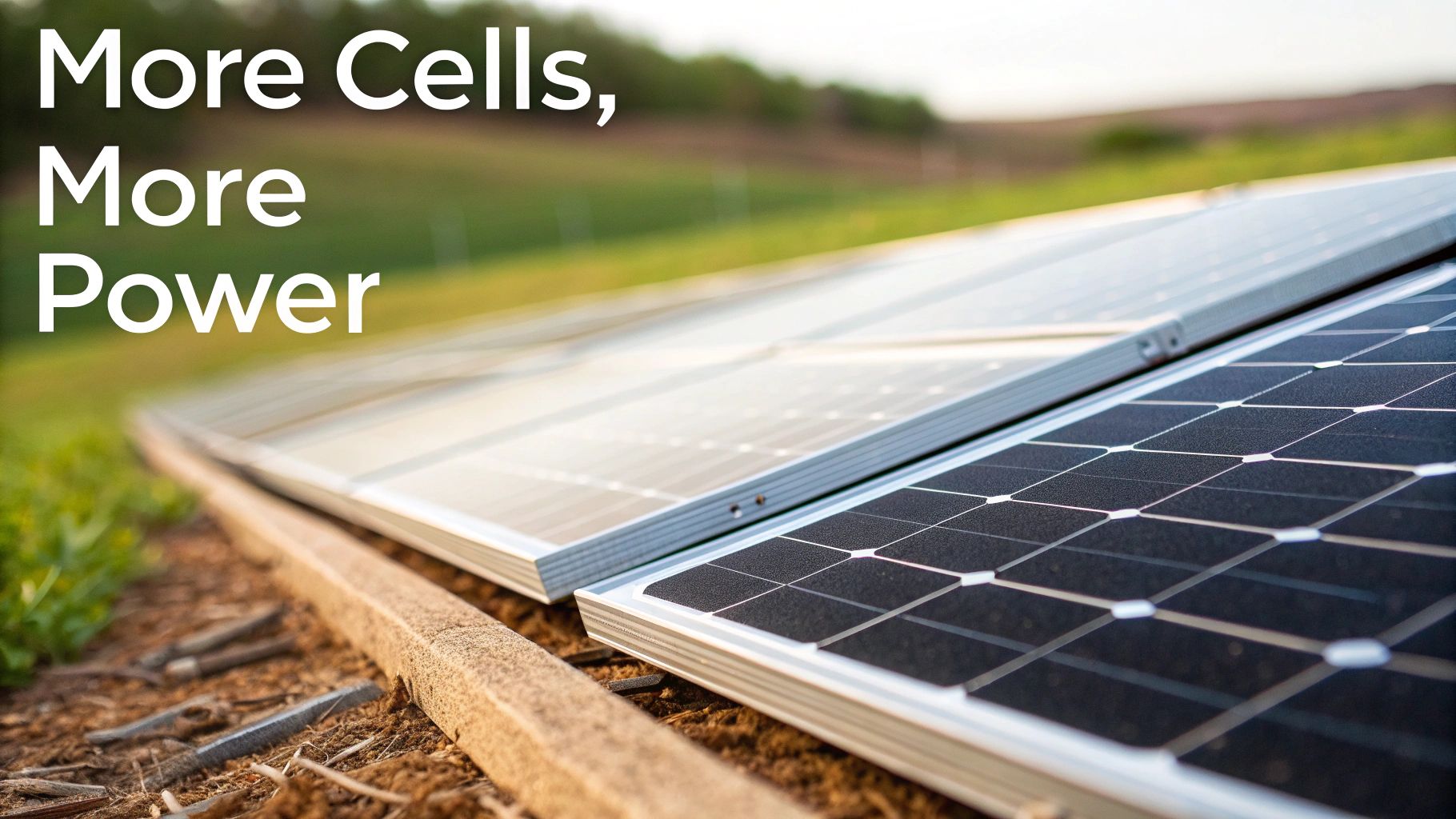
Solar panel sizes aren't just picked out of a hat; they're the result of careful engineering. The biggest factor influencing a panel's dimensions is the number of individual solar cells packed inside it. It's helpful to think of these cells like the pixels on a TV screen—the more you have, the bigger and more powerful the final product.
This is why you'll often see panels categorized by their cell count. For most home installations, the two most common layouts are 60-cell and 72-cell panels. As you might guess, the 72-cell versions are physically larger, usually longer, to accommodate the extra cells.
Power Rating and Cell Technology
But it’s not just about how many cells you can fit. The panel's power rating, measured in watts (W), is just as important. A higher wattage means the panel is better at converting sunlight into electricity, and this capability comes down to the technology of the cells themselves.
Today, you'll mainly find two types of solar cells:
- Monocrystalline: These are the high-performers. Made from a single, pure silicon crystal, they are incredibly efficient and can generate more power from a smaller footprint. This makes them a great choice for homes where roof space is tight.
- Polycrystalline: Created by melting multiple silicon fragments together, these cells are a bit less efficient. To get the same power output as a monocrystalline panel, you’ll typically need a larger polycrystalline one.
Because of this, a high-efficiency 400W monocrystalline panel could be the exact same size as a lower-efficiency 350W polycrystalline panel. The real difference is the power-producing technology under the glass. You can take a deeper dive into the parts of solar panels to see how everything fits together.
The key thing to remember is that a panel's size is always a trade-off between its physical cell count, the efficiency of its cell technology, and its total power output.
So, when we ask "how big is a solar panel?" the answer is about much more than just inches and feet. It's really about the amount of power packed within those dimensions.
When you start looking into solar panel sizes, you'll quickly notice they're not all the same. The biggest split is between the panels you see on a neighbor's house and the ones used for massive commercial projects. It’s a bit like comparing the engine in your family car to the powerhouse inside a freight train—both do a similar job, but they’re built for entirely different scales.
Residential panels are designed with a home's roof in mind. That means they’re generally smaller and lighter, making it much easier for a crew to carry them up a ladder and maneuver them on a sloped, sometimes tricky, surface. The goal is a perfect blend of power generation for a typical family and a practical size that's easy to handle and secure.
The Commercial-Grade Difference
Commercial solar panels are a different beast altogether. They’re built on a simple principle: squeeze out every last drop of power. You'll find these giants on the huge, flat roofs of warehouses or covering acres of land in a solar farm. In those scenarios, maximizing efficiency and scale is the name of the game.
Because of this, commercial panels are noticeably larger and heavier. Their job is to capture as much sunlight as possible in a single unit. A single commercial panel can pack a much bigger punch than a residential one, which means fewer panels are needed for a large-scale project. This simplifies the installation and reduces the number of connections, which is a big win for project efficiency.
For a little perspective, a standard residential panel is often around 1.6 by 1 meter and kicks out 300 to 400 watts. Commercial panels can stretch over 2 meters long and can produce up to 600 watts. For more data on these market trends, you can check out reports from places like Fortune Business Insights.
Key Insight: The choice boils down to manageability versus raw power. Residential panels are sized for easy installation on home roofs, while commercial panels are built to maximize wattage over large, open areas.
This isn't just a minor detail; it impacts everything. The size difference affects installation logistics, the type of mounting equipment needed, and the overall cost and performance of the system. A homeowner is thinking about how to best fit an array on their roof, while a commercial developer is calculating how to maximize energy output per acre.
How Panel Size Impacts Your Home Solar Project
When you're planning a solar installation, the physical size of the panels is more than just a number on a spec sheet—it shapes the entire project. It dictates how many panels can actually fit on your roof, which in turn determines your system's total power output and, ultimately, the final cost.
Think of your roof as a giant, fixed-size puzzle board. You have a limited amount of space to work with. If you choose larger, more powerful panels, you can complete your energy "puzzle" with fewer pieces, which is a huge advantage when space is tight. It’s a strategic decision every homeowner has to make.
Maximizing Your Roof Space
The name of the game is squeezing the most power possible out of your available roof area. This is where panel efficiency really shines. More efficient panels can produce more electricity from the same physical footprint, making them a lifesaver for homes with small or complicated rooflines.
Let's look at a real-world example. To build a typical 6kW residential solar system, you'd have a choice:
- You could use 20 standard 300W panels.
- Or, you could achieve the same goal with just 15 higher-wattage 400W panels.
graph TD
subgraph 6kW Solar System Options
A[<b>Option 1: 300W Panels</b><br/>20 Panels Needed<br/>More Roof Space Required] --> C{Total Power: 6,000W};
B[<b>Option 2: 400W Panels</b><br/>15 Panels Needed<br/>Less Roof Space Required] --> C;
end
Fewer panels means a simpler, faster installation and less hardware on your roof. This is especially important for residential projects, where panels are smaller for easier handling on sloped roofs, compared to the much larger panels used on vast commercial rooftops.
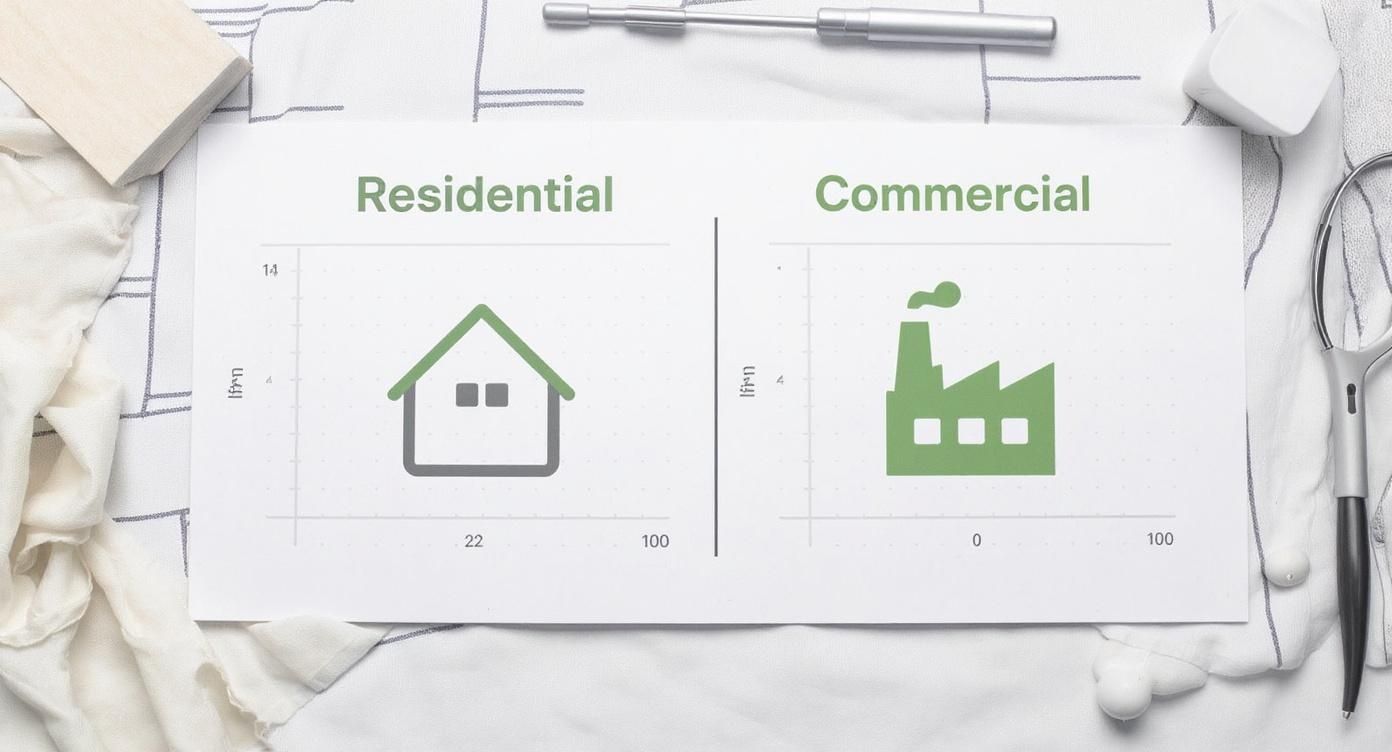
The takeaway here is that you're always optimizing for your specific situation. Integrating solar effectively is a key part of modern sustainable building, and understanding how panel sizes work with different eco-friendly house plans can make or break a project's success.
Choosing the right panel size isn't just about dimensions; it's about creating the most productive and cost-effective system for your unique home and energy needs.
At the end of the day, it's all about balancing the physical limitations of your roof with your performance goals. To dive deeper into the calculations, check out our guide on https://radiantenergysolar.com/how-to-size-a-solar-system/ to ensure you're making a smart investment that will pay off for years to come.
The Evolution of Solar Panel Technology
To really wrap your head around the question, "how big is a solar panel?", we need to appreciate just how far the technology has come. The panels you see today are a world away from what was available a decade ago, offering homeowners a huge leap in both power and efficiency.
Think of it like comparing a smartphone from 2010 to a new one today. They might look similar, but the performance is night and day. Early solar panels were much the same—less effective at turning sunlight into usable electricity, which meant you needed a lot more of them to power your home.
More Power in a Smaller Space
Thanks to some incredible breakthroughs in photovoltaic science, manufacturers can now pack way more power into a similar-sized frame. This progress is a game-changer. It means a single, modern panel can generate far more electricity than its older cousins, giving you a much bigger bang for your buck.
Let's look at the numbers. Back in 2010, a standard residential panel might have produced around 250 watts. Fast forward to today, and it’s common to see panels in the 300 to 450 watt range, often without a massive increase in size. That’s a serious jump in power density. You can explore more about these market trends and see the data behind this impressive growth.
gantt
title Growth in Typical Residential Solar Panel Wattage
dateFormat YYYY
axisFormat %Y
section Panel Output
2010 :done, 2010, 250W
Today :active, 2024, 300W-450W
This is fantastic news, especially if you have limited roof space. You can now meet your energy goals with fewer panels, which often means a simpler, more cost-effective installation.
The key takeaway is that an investment in solar today provides more power and value than ever before. Modern panels are not just bigger or smaller; they are fundamentally better at their job.
This rapid evolution means that when you decide to go solar now, you’re getting a mature, high-performance technology that can easily handle the energy demands of a modern home. You get a more powerful system without needing a bigger roof.
Got Questions About Solar Panel Size? We've Got Answers.
It's one thing to read about solar panel dimensions, but it's another to understand what those numbers mean for your roof and your wallet. Let's tackle some of the most common questions people have when they start sizing up a solar project.
Is a Bigger Solar Panel Automatically Better?
Not always. While it's true that a larger panel often packs more wattage, the real MVP is efficiency. Think of efficiency as how well a panel turns sunlight into usable power within a given area.
A smaller, super-efficient panel can easily out-produce a bigger, less efficient one. The "best" panel is all about what fits your situation. If you've got a small or awkwardly shaped roof, a compact, high-efficiency panel is your best bet for squeezing every last watt out of your available space.
How Much Do These Things Actually Weigh?
Weight is a big deal—your roof has to be able to handle the load safely. A typical residential solar panel weighs somewhere between 40 and 50 pounds (or 18 to 23 kilograms). The beefier panels designed for commercial projects can tip the scales at over 60 pounds.
Don't worry, though. No reputable installer would ever start work without first doing a full structural check on your roof. This inspection makes sure it can comfortably support the total weight of the panels and all the mounting gear for decades to come.
Your roof's ability to safely carry the load is non-negotiable. A certified pro will always verify its structural integrity before a single panel goes up, giving you peace of mind.
Can I Mix and Match Different Panel Sizes?
Mixing panels of different sizes or wattages is generally a bad idea if they're all connected together in the same string (think of it like a chain of Christmas lights). The entire string's performance gets dragged down to the level of the weakest panel, creating a major energy bottleneck.
That said, modern systems with microinverters or power optimizers are much more flexible. These technologies allow each panel to work independently, so a mismatch isn't as big of a problem. Even with this tech, you'll want an expert to design the system to make sure everything plays nicely together for optimal safety and output.
How Does Panel Size Impact the Installation Cost?
The size of the panels you choose can affect the final price tag in a couple of ways. On one hand, bigger and heavier panels might require an extra set of hands or special lifting equipment to get them on the roof, which could bump up the labor cost a bit.
But on the other hand, larger, more powerful panels mean you need fewer of them to hit your energy target. Fewer panels can mean less racking, fewer connections, and a simpler overall installation, which can actually save you money. A good installer will walk you through these trade-offs and provide a quote that breaks it all down.
Ready to find the perfect-sized solar solution for your home? The experts at Radiant Energy are here to design a system that maximizes your roof space and energy savings. Get your free, no-obligation quote today!

